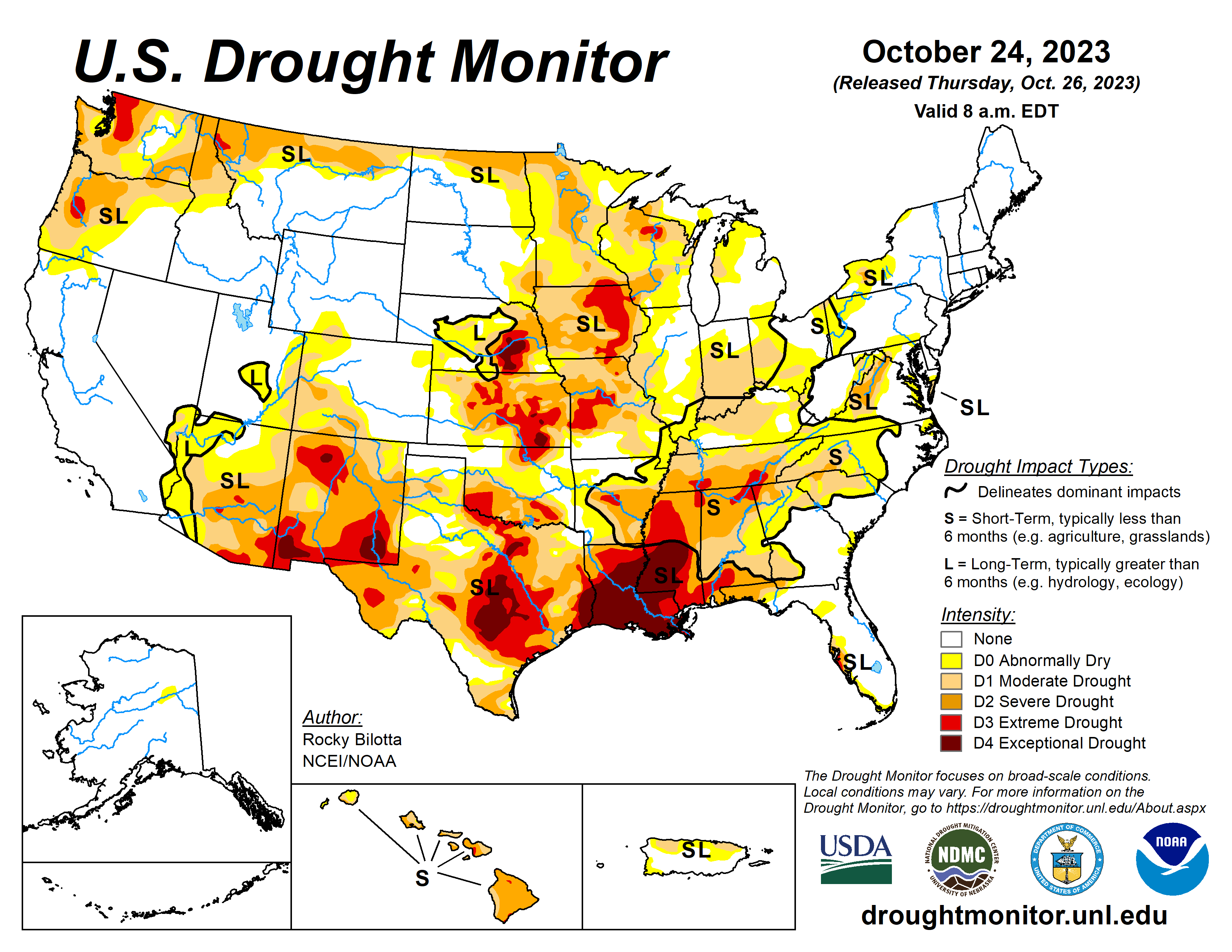Colder weather expected to hit High Plains region

A strong upper-level ridge dominated much of the western United States. This caused anomalously warm temperatures, by as much as 20 degrees Fahrenheit above average, and dry conditions occurred over the central and western parts of the country.
A front extending from the Great Lakes to the Gulf Coast produced rain over parts of Ohio Valley and Great Lakes before moving eastward and bringing rain to parts of the Northeast and Southeast.
The most widespread improvements were made to parts of eastern Texas, central Wisconsin and in parts of the Ohio River Valley, where above-normal precipitation was observed this past week. Dry conditions continued across much of the southern region, with widespread degradations occurring across the Tennessee Valley, central Mississippi Valley and northern parts of the Southeast.
In the Southwest, near- to record-warm temperatures coupled with below-normal precipitation for the month, resulted in degradation in the southern parts of the region.
South
Dry conditions continued across much of the southern region while heavy precipitation fell over parts of eastern Texas to southern Oklahoma. Portions of the Texas Panhandle received up to 4 inches of rainfall (up to 600% above normal) this week. That total meant the removal of exceptional drought (D4) while extreme drought (D3) and severe drought (D2) conditions were improved in this region.
On the dry side, a broad 1-category degradation was made to Arkansas, Tennessee and in northern parts of Mississippi and Louisiana, where little to no precipitation fell. Extreme drought was expanded in southeast Louisiana, while D3 was expanded in northern Louisiana, northern Mississippi and introduced in parts of central Arkansas and southern Tennessee.
Precipitation in these areas are around 2 to 3 inches below normal for the month. The drought expansion and intensification was based on short-term SPI/SPEI, NDMC’s short-term blend, streamflow and soil moisture data.
Midwest
A broad 1-category improvement was made across much of the northern Ohio Valley, central Wisconsin and western Minnesota, where 0.5 to 3 inches of rainfall (up to 400% of normal) occurred.
Above-normal precipitation helped to alleviate longer-term precipitation deficits and improved soil moisture and streamflow impacts, resulting in improvements to abnormal dryness (D0) and all drought categories.
Severe drought (D2) improved in southern Minnesota and northeast Wisconsin, while moderate drought (D1) was improved in southern Minnesota, central Wisconsin, western Kentucky and Ohio. Meanwhile, dry conditions continue to affect southern parts of the region, where precipitation is as low as 5% of normal for the week. D0 to D2 was expanded across parts of Missouri, while D1 was expanded into southern Illinois and eastern Kentucky. Degradations were supported by precipitation deficits, short-term SPI/SPEI timescales, streamflow and soil moisture data.
High Plains
Precipitation fell over the northern and eastern parts of the region, with much of the rain falling outside of the drought areas. For this reason, much of the High Plains remained as status quo this week.
Little to no precipitation fell over most of Nebraska, Kansas, Colorado and southern Wyoming. This coupled with above-normal temperatures (around 10 to 15 degrees above normal), along with deteriorating conditions shown in short-term SPI/SPEI, streamflow and soil moisture data, justified slight degradations across these states.
Severe drought (D2) was expanded in northeast Kansas, while moderate drought (D1) was expanded in the southeast part of the state. D1 was also expanded in parts of southwest Wyoming. An abnormal dryness (D0) was expanded from southwest Nebraska into northeast Wyoming and D0 was introduced along the central border of Kansas and Wyoming.
West
Much of the West remained as status quo. Precipitation fell across much of the region, which was enough to prevent further degradation but not enough to warrant large improvements. Heavier precipitation fell across parts of Montana, with rain totals up to 300 to 400% above normal.
This beneficial rainfall, along with precipitation percentiles and short-term SPI/SPEI, soil moisture and streamflow data, resulted in abnormal dryness (D0) and moderate (D1) to severe (D2) drought improvements along the northern parts of Montana. As for temperature, much of the region was well above normal with temperatures up to 15 degrees above normal.
Parts of the Southwest are experiencing record warm temperatures for this month-to-date period. Phoenix, Arizona, reached 105 degrees on Oct. 16 and 104 degrees on Oct. 19 and 20, setting the three hottest temperatures on record for this time of the year. These above-normal temperatures coupled with below-normal precipitation resulted in the expansion of D1 and D2 in southern Arizona and across the state of New Mexico. Introduction of D3 was also added to northwest New Mexico based on precipitation deficits and short-term SPI/SPEI and soil moisture data.
Looking ahead
During Oct. 24 to 28, remnant energy and moisture from Tropical Storm Norma could stream northward to spread heavy rainfall to parts of the southern and central U.S. early to mid-next week. Chances of snow increase in the northern Rockies and into parts of the northern Plains late next week.
The Weather Prediction Center has highlighted a slight risk of excessive rainfall for parts of northern Texas and west-central Oklahoma due to potential flash flooding. Well above normal temperatures will spread from the Midwest into the East (15 to 20 degrees above normal), while daytime maximum temperatures for the northern portions of the Rockies and Plains could be 10 to 20 degrees below normal.
Sign up for HPJ Insights
Our weekly newsletter delivers the latest news straight to your inbox including breaking news, our exclusive columns and much more.
The Climate Prediction Center’s outlook for Oct. 28 to Nov. 2 favors near to above-normal precipitation throughout much of contiguous U.S. Below normal precipitation is likely for the northern Plains.
Rocky Bilotta is with the National Oceanic Atmospheric Administration and National Centers for Environmental Information.



